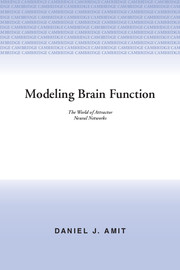Book contents
- Frontmatter
- Contents
- Preface
- Dedication
- 1 Introduction
- 2 The Basic Attractor Neural Network
- 3 General Ideas Concerning Dynamics
- 4 Symmetric Neural Networks at Low Memory Loading
- 5 Storage and Retrieval of Temporal Sequences
- 6 Storage Capacity of ANN's
- 7 Robustness - Getting Closer to Biology
- 8 Memory Data Structures
- 9 Learning
- 10 Hardware Implementations of Neural Networks
- Glossary
- Index
7 - Robustness - Getting Closer to Biology
Published online by Cambridge University Press: 05 August 2012
- Frontmatter
- Contents
- Preface
- Dedication
- 1 Introduction
- 2 The Basic Attractor Neural Network
- 3 General Ideas Concerning Dynamics
- 4 Symmetric Neural Networks at Low Memory Loading
- 5 Storage and Retrieval of Temporal Sequences
- 6 Storage Capacity of ANN's
- 7 Robustness - Getting Closer to Biology
- 8 Memory Data Structures
- 9 Learning
- 10 Hardware Implementations of Neural Networks
- Glossary
- Index
Summary
Synaptic Noise and Synaptic Dilution
Two meanings of robustness
In Section 1.2.1, we listed some of the simplifying assumptions involved in the construction of the models discussed so far. Many more assumptions may have been detected by the reader along the way. No amount of lifting of simplifications will closely approximate the full glory of an assembly of real live neurons. Yet, as the grossest assumptions are replaced by more realistic ones and as the model is modified to account for more complex types of behavior without a significant loss in its basic functional features and in its effectiveness, the model gains in plausibility. To recapitulate our general methodological point of view: The lifting of simplifications is not performed as an end in itself. If the more complicated system functions in a qualitative way that can be captured by the simplified system, then the complication is removed and analysis continues with the simplified system.
We shall recognize two types of robustness, related to two types of results:
Robustness of specific properties to perturbation of the underlying parameters.
Robustness of general features to modifications required by more complex functions.
Since this chapter will be primarily concerned with robustness of the first kind we start by giving examples of situations of the second kind.
- Type
- Chapter
- Information
- Modeling Brain FunctionThe World of Attractor Neural Networks, pp. 345 - 386Publisher: Cambridge University PressPrint publication year: 1989



